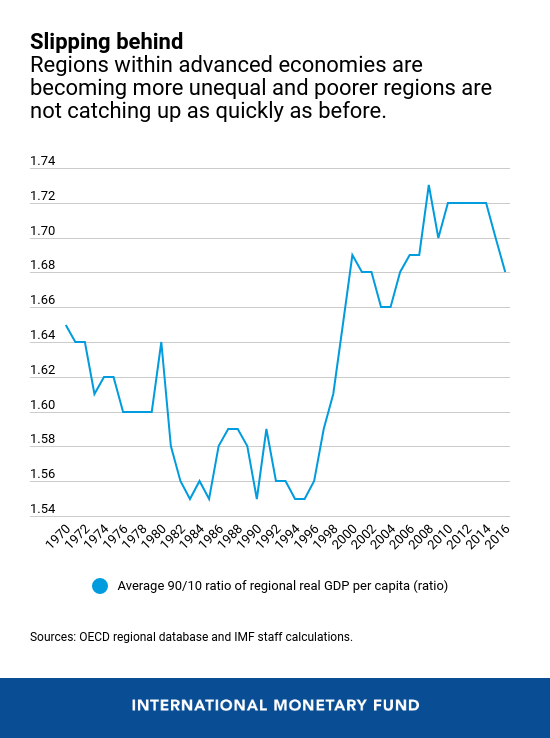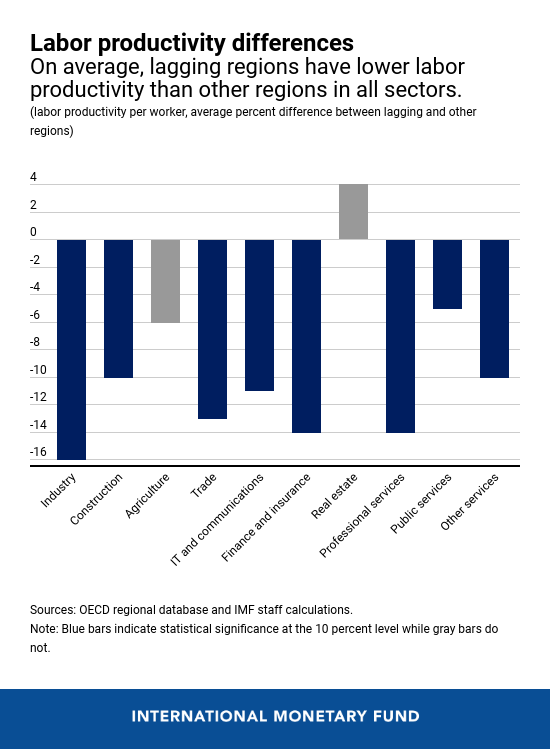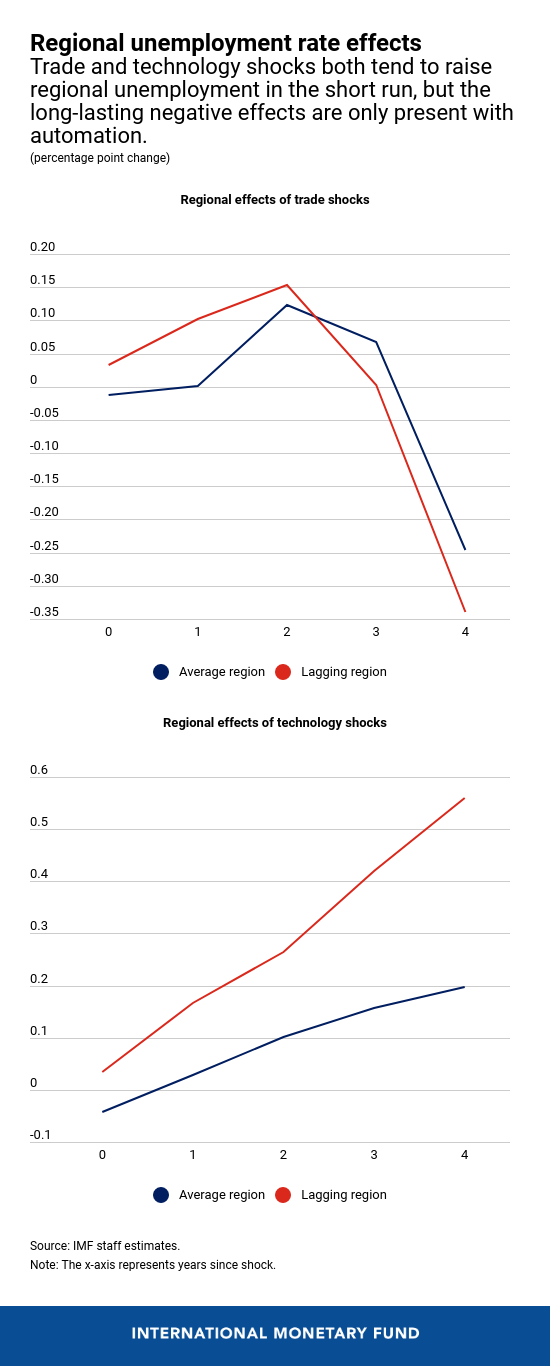Differences in economic performance between regions within countries can be large and sometimes even larger than between countries.
For example, average real GDP per person in the United States is about 90 percent higher than in Slovakia. At the same time, within the United States, per capita GDP in the state of New York is 100 percent higher than in Mississippi.
Many are concerned that these large and persistent gaps signal that regions and people are being left behind, undermining inclusive growth. Poor regional performance can fuel discontent and erode social trust and cohesion.
Chapter 2 of the latest World Economic Outlook looks at the gaps between the better and worse performing regions in advanced economies and finds that these gaps have widened in many cases. We also look at how regional labor markets respond to trade and technology shocks, captured by increases in import competition in external markets and declines in machinery and equipment costs for regions that are more vulnerable to automation. The findings indicate that only technology shocks have lasting effects, especially for worse performing regions.
Differences in economic performance between regions within countries can be large.
Measuring regional differences
One way to measure regional inequality is to calculate the 90/10 ratio—divide real GDP per capita in the region at the 90th percentile by that of the region at the 10th percentile within a country. In the case of Italy, the 90/10 ratio is about 2, meaning that GDP per capita of the well-off province of Trento is about twice as large as Sicily’s. In contrast, the 90/10 ratio for Japan is small, at 1.35.
Regional disparities within advanced countries have gradually been creeping upwards since the late 1980s, undoing some of the marked decline of the previous three decades. The 90/10 ratio within advanced economies, including the United States, is now at about 1.7, indicating that the 90th percentile region is, on average, 70 percent richer than the 10th percentile region. That said, incomes tend to vary much more within regions than between them.
Rising disparities also means that poorer regions in advanced economies are no longer catching up to the rich as fast as they used to.
Big differences
The WEO chapter classifies a region as lagging if two conditions are met: the region’s initial real GDP per capita in 2000 is below the country’s median region, and the region’s average growth over the period 2000–16 is below the country’s average growth over the same period.
But there are more differences than just output. On average, people in lagging regions are worse off when it comes to health, with higher infant mortality and lower life expectancy. They also have smaller shares of college-educated workers and people in their prime, considered to be 25 to 54 years old, higher unemployment rates, and a smaller share of people participating in the labor force.
Consistent with these unfavorable demographics, lagging regions tend to have lower labor productivity—output per worker—across sectors. This ranges from about 5 percent less in public services to around 15 percent less in manufacturing industries and finance and professional services.
In addition, poorer regions tend to specialize in agriculture and manufacturing industries rather than high productivity service sectors such as information technology and communications and finance. Climate change may exacerbate disparities as rising temperatures lower labor productivity in agriculture and heat-exposed industries, often affecting lagging regions more.
Responses to shocks
To get a better sense of regional differences, our study analyzes the effects of trade and technology shocks on regional unemployment and migration.
We find that trade shocks—increases in import competition in external markets—do not have significant effects on regional unemployment on average, both overall and for lagging regions specifically. While these shocks tend to reduce labor force participation after one year, this effect quickly fades. These findings may come as a surprise to those who view international trade as particularly disruptive to regional growth.
Technology, however, is a different story. We find that a negative technology shock—proxied by a decline in the cost of machinery and equipment—raises unemployment in all regions that are more vulnerable to automation, but lagging regions are particularly hurt.
Our research also shows that automation-prone lagging regions see a statistically significant drop in people leaving after the shock. This suggests that workers from these regions find it harder to move out in search of better employment than those from other regions. Labor’s adjustment to technology shocks in lagging regions is hampered.
Focus on people and places
Policies that reduce distortions and encourage more open and flexible markets can help regions minimize increases in unemployment to shocks and improve the reallocation of workers and capital. Labor policies to retrain the displaced and speed re-employment can also help, particularly in lagging regions. Product markets that are more open—through lower barriers to entry and greater trade openness—can facilitate the movement of capital to regions and firms where their returns are higher.
In addition, boosting educational and training quality to adapt to the changing world of work—a key recommendation from the literature—would disproportionately benefit lagging regions where unemployment is higher.
Finally, fiscal policies that aim to narrow the gaps across regions—such as targeting fiscal support to lagging regions and programs to ease worker relocation—and to provide buffers against regional shocks may also play a role. But these place-based policies have to be carefully designed to help rather than hinder adjustment.









